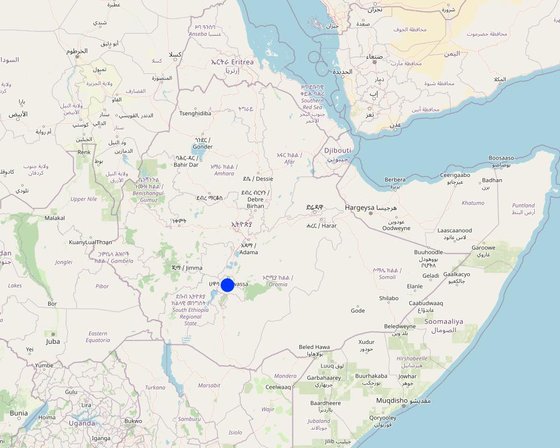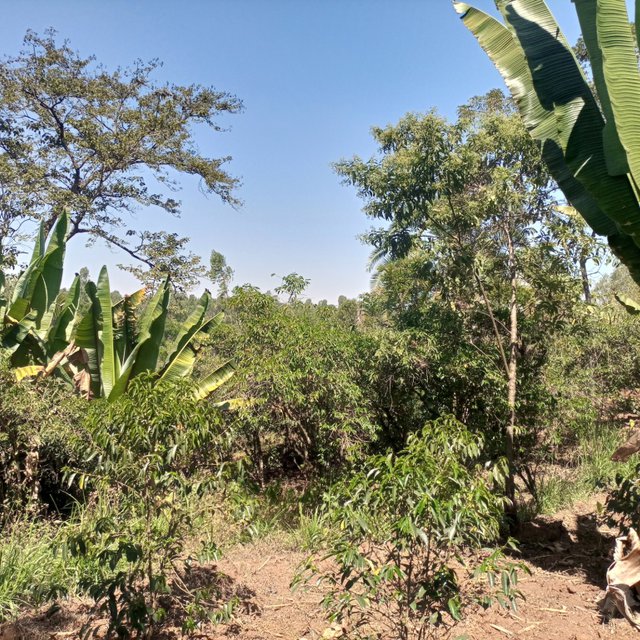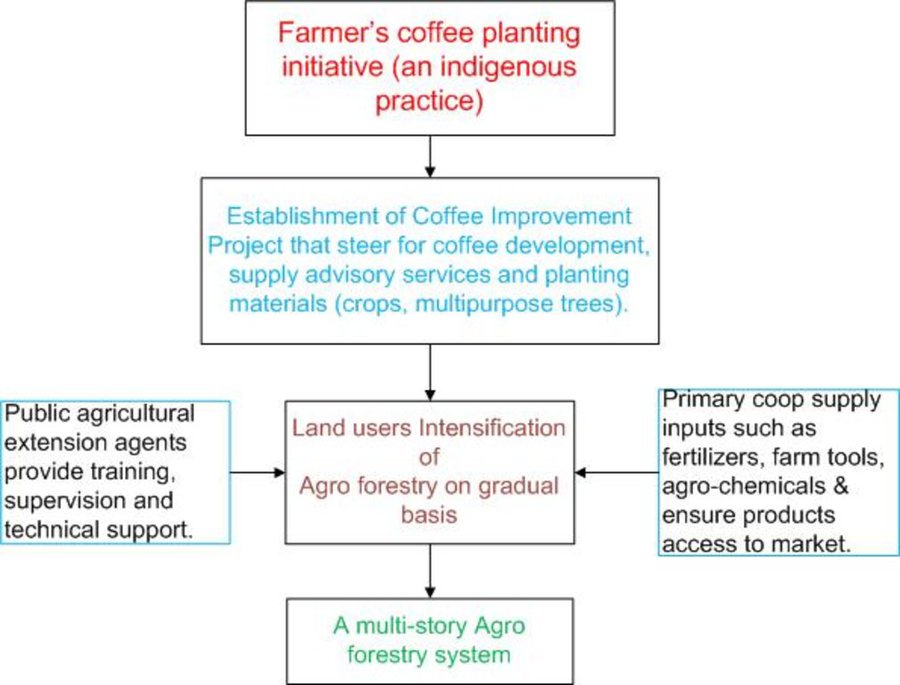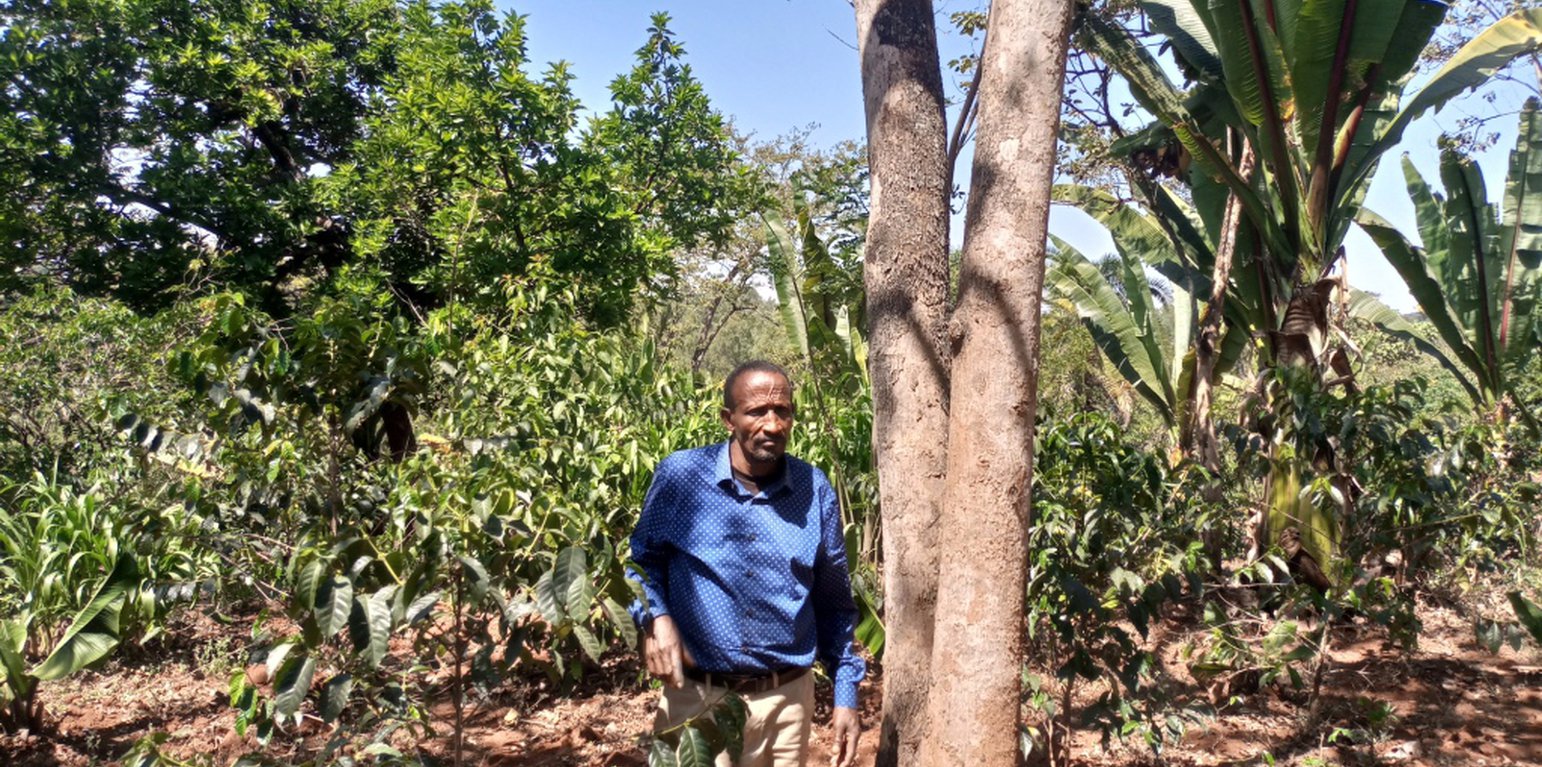Integrated Agroforestry System
(Ethiopia)
Mitikarsamino Ersha
Description
The integrated agroforestry system is a self-initiated approach by a land user to implement agroforestry as part of an indigenous practice and has evolved over the years through technical support, training, and supplies of coffee and tree seedlings by the Office of Agriculture and Coffee Improvement Project. Had there been a participatory process throughout it would have helped in design and also in scaling up.
The integrated agroforestry system was independently initiated by land users during the Derg regime (1974-91). During the regime, farmers were failed by two distinct and polar development approaches: socialist and the mainstream local approaches. The earlier one involved the communist approach of communal production and sharing the output according to contribution. The latter ones employed a conventional approach and included non-members of the so-called Farmers Producer Cooperatives. As a non-member of the earlier one, the land user had to develop his farm alone. The solitary agroforestry initiative described here has gradually evolved to a fully-fledged system that currently serves as a model SLM practice for scaling up across similar agroecological and farming system. Thus, there was little participation involved during the early intensification of agroforestry in Ethiopia. Rather, it is considered an indigenous practice that now receives publicity as a form of “regenerative agriculture” with ecological, economic, and social benefits. As it has global significance in terms of emission reduction and sequestration of carbon, it is the favourite technology among the government and other development practitioners.
The farmer started agroforestry by planting enset and coffee. Over time, with emerging technical support, access to training, and supply of coffee seedlings by the agriculture and coffee improvement project offices, the land user has continued intensification of the agroforestry around the homestead by adopting the correct planting space for coffee and enset, and other companion fruit, fodder crops, and shade trees. The former Ministry of Coffee and Tea, and the current Ministry of Agriculture have had an immense contribution by supplying technical support, training, and inputs (notably coffee and tree seedlings), and by ensuring access to fertilizers. The latter was supplied to the farmers on a credit basis through the then Service Cooperative.
As the initiative was the farmer's own, the tendency to plant incompatible crops was not uncommon. Even so, the agroforestry trees and shrubs still had immense ecological and economic value. They ameliorate the extreme temperature experienced during the dry season, improve the microclimate, recharge the surface and groundwater via improving water infiltration, and reduce runoff losses. Improving soil fertility and soil health are among other benefits. Despite the substantial benefit the technology confers on land users, the lack of a participatory approach in planning, implementation, monitoring, and evaluation at the community level restricts the adoption and scaling up of this beneficial approach. Despite the achievements of the land user, earlier engagement of other smallholders and institutionalizing the approach decades ago might have positively influenced the design as well as wider-scale adoption and application of the technology. However, regardless of any limitations, the technology is evidence-based and inspirational.
Location

Location: Shoye kebele (Kebele - lower administrative level)., Sidama, Ethiopia
Geo-reference of selected sites
Initiation date: 1980
Year of termination: n.a.
Type of Approach
-
traditional/ indigenous
-
recent local initiative/ innovative
-
project/ programme based

The photo portrays the diverse components of the agroforestry system (GERBA LETA)
Approach aims and enabling environment
Main aims / objectives of the approach
A traditional approach was initiated to change the land use/ land cover and optimize the benefit of the degraded land by reducing the negative effects of overgrazing and its consequence.
Conditions enabling the implementation of the Technology/ ies applied under the Approach
-
Social/ cultural/ religious norms and values: The long-standing tradition of the society promotes planting and preserving trees.
-
Availability/ access to financial resources and services: Access to in-kind credit services such as fertilizers from farmers' cooperatives enables the land users to effectively implement the practice.
-
Collaboration/ coordination of actors: Foster farmers access to training, technical support, exchange visit...
-
Legal framework (land tenure, land and water use rights): Enables the development of a sense of ownership and accountability to properly implement and manage the practice.
-
Knowledge about SLM, access to technical support: Promote effective implementation, management, and use of the return from the practice.
-
Markets (to purchase inputs, sell products) and prices: The availability of a fair and subsidized market enables the approach.
-
Workload, availability of manpower: The availability of manpower enables one to accomplish the job without pressure.
Conditions hindering the implementation of the Technology/ ies applied under the Approach
-
Institutional setting: The lack of institutional setting might have influenced the rate of scaling the technology.
-
Markets (to purchase inputs, sell products) and prices: Lack of reliable market compels to change the approach to another income-generating practice/approach.
-
Workload, availability of manpower: Shortage of manpower disables effective implementation of the practice.
Participation and roles of stakeholders involved
Stakeholders involved in the Approach and their roles
| What stakeholders / implementing bodies were involved in the Approach? |
Specify stakeholders |
Describe roles of stakeholders |
| local land users/ local communities |
Land users and local communities |
Plan and implement the technology, and sharing labor, skills and knowledge. |
| SLM specialists/ agricultural advisers |
Development agents (DAs) and district experts |
Provide training, and technical support, facilitate land users' access to inputs such as seedlings and fertilizers, monitor and evaluate, and documentation of successful practices for pervasive application and use. |
| researchers |
Regional Agricultural Research Institute, and under/graduate students. |
Generate supportive specific and relevant technologies, learn the lesson, and recommend best-fit technologies/practices. |
| local government |
District administration and colleagues |
Acknowledge the farmers/technology adopters as a model to showcase their experience and encourage the scaling out of the initiative. |
Involvement of local land users/ local communities in the different phases of the Approach
none
passive
external support
interactive
self-mobilization
initiation/ motivation
Land user: Initiated coffee and enset plantation little by little and accessed training and technical support from DAs and Woreda office of Agriculture experts.
planning
Land user and development agent: In consultation with DAs, the land users plan based on available labor and capital every other year.
implementation
Land users and family member. They involved in various implementation/management activities.
monitoring/ evaluation
Government development agents, and experts coordinate mobilization of the communities to visit and learn from the ongoing practice.
Flow chart
A flow chart depicting the evolution of practice from self-initiative indigenous coffee planting practices to a multistorey agroforestry system with the participation and support of public organization agents and farmers' primary cooperative.

Author: Gerba Leta
Decision-making on the selection of SLM Technology
Decisions were taken by
-
land users alone (self-initiative)
-
mainly land users, supported by SLM specialists
-
all relevant actors, as part of a participatory approach
-
mainly SLM specialists, following consultation with land users
-
SLM specialists alone
-
politicians/ leaders
Decisions were made based on
-
evaluation of well-documented SLM knowledge (evidence-based decision-making)
-
research findings
-
personal experience and opinions (undocumented)
Technical support, capacity building, and knowledge management
The following activities or services have been part of the approach
-
Capacity building/ training
-
Advisory service
-
Institution strengthening (organizational development)
-
Monitoring and evaluation
-
Research
Capacity building/ training
Training was provided to the following stakeholders
-
land users
-
field staff/ advisers
-
Development agents
Form of training
-
on-the-job
-
farmer-to-farmer
-
demonstration areas
-
public meetings
-
courses
-
Training and visit
Subjects covered
Coffee production and management such as preparation of planting pits, refilling the soil back to the pit, planting space, fertilizer application, weeding, mulching, planting shade trees, etc.
Advisory service
Advisory service was provided
-
on land users' fields
-
at permanent centres
The training used to be given in permanent centers such as development stations in the past and Farmers Training Center since recent a decade ago and was associated with a visit to a farmers field.
Financing and external material support
Annual budget in USD for the SLM component
-
< 2,000
-
2,000-10,000
-
10,000-100,000
-
100,000-1,000,000
-
> 1,000,000
Precise annual budget: n.a.
Only in kind support such as coffee seedlings and technical support such as advisory service was provide by the government agricultural office through development/extension agents. Otherwise, it is privately financed business with main expense geared toward supplying seedlings and agricultural inputs such as fertilizers.
The following services or incentives have been provided to land users
-
Financial/ material support provided to land users
-
Subsidies for specific inputs
-
Credit
-
Other incentives or instruments
Financial/ material support provided to land users
In the past (during Derg regime) there was subsidy for fertilizers as a country which is entirely removed in the recent years.
partly financed
fully financed
Fertilizer
In the past, the government import and supply fertilizer on subsidized basis. The trend was changed over the last a couple of decades.
Labour by land users was
-
voluntary
-
food-for-work
-
paid in cash
-
rewarded with other material support
Impact analysis and concluding statements
Impacts of the Approach
No
Yes, little
Yes, moderately
Yes, greatly
Did the Approach empower local land users, improve stakeholder participation?
The approach was mainly based on self initiative. The assistance that came in later on was top-down where farmers were urged to plant coffee and companion tree crops. However, later it has evolved into agroforestry and SLM that empower local land users to join.
Did the Approach enable evidence-based decision-making?
It is not entirely the approach but the outcome of intensifying the technology that eventually enables land users and other stakeholders to make an evidence-based decision.
Did the Approach help land users to implement and maintain SLM Technologies?
The prevailing system compels farmers to integrate land management practices such as soil bunds, food and non-food tree species into the farm that enable land users to adopt and uphold SLM technology.
Did the Approach improve coordination and cost-effective implementation of SLM?
Did the Approach mobilize/ improve access to financial resources for SLM implementation?
,
Did the Approach improve knowledge and capacities of land users to implement SLM?
Through public meetings and social learning from peers and better-off farmers, land users' knowledge and skills to implement the technology have been improved.
Did the Approach improve knowledge and capacities of other stakeholders?
Virtually through social learning and labor sharing.
Did the Approach build/ strengthen institutions, collaboration between stakeholders?
It was a solitary approach but later adopted by numerous land users.
Did the Approach mitigate conflicts?
Did the Approach empower socially and economically disadvantaged groups?
It doesn't deliberate about gender disparity and equity as it was an indigenous initiative in the long past.
Did the Approach improve gender equality and empower women and girls?
Did the Approach encourage young people/ the next generation of land users to engage in SLM?
The established technology built youths trust in SLM.
Did the Approach improve issues of land tenure/ user rights that hindered implementation of SLM Technologies?
Did the Approach lead to improved food security/ improved nutrition?
Actually, implementing the agroforestry improved food and nutrition security of the family farmers.
Did the Approach improve access to markets?
Harvest from the integrated system improved farmer's access to market.
Did the Approach lead to improved access to water and sanitation?
Did the Approach lead to more sustainable use/ sources of energy?
Through promoting biogas technology in mixed tree-crop-livestock system.
Did the Approach improve the capacity of the land users to adapt to climate changes/ extremes and mitigate climate related disasters?
Again, it is not the approach but the applied technology has improved farmers adaptation to climate change/climate variability.
Did the Approach lead to employment, income opportunities?
It creates all year round employment opportunity for family labor and other casual laborers.
Main motivation of land users to implement SLM
-
increased production
-
increased profit(ability), improved cost-benefit-ratio
-
reduced land degradation
-
reduced risk of disasters
-
reduced workload
-
payments/ subsidies
-
rules and regulations (fines)/ enforcement
-
prestige, social pressure/ social cohesion
-
affiliation to movement/ project/ group/ networks
-
environmental consciousness
-
customs and beliefs, morals
-
enhanced SLM knowledge and skills
-
aesthetic improvement
-
conflict mitigation
Sustainability of Approach activities
Can the land users sustain what hat been implemented through the Approach (without external support)?
Despite the implementation approach employed by the land user, the technology is highly commended by the land users and the public at large. The income generated from the sale of crops adequately supports the livelihoods of family farmers as well as effectively finances the maintenance of the system. However, the new beginners need external support to make sure the technology is properly implemented and scaled out for wider application and use.
Conclusions and lessons learnt
Strengths: land user's view
-
Enables improved crop production and productivity and reduces risks of crop failure due to climate change/variability.
-
Motivate farmers to reduce soil erosion and land degradation and improve soil fertility.
-
The approach creates an enabling environment to intensify agroforestry and improve the microclimate of the area and ensure sustainability of the system.
-
Increased land users' status in the community to feel confident as local elites and friendliness to the environment.
Strengths: compiler’s or other key resource person’s view
-
The agroforestry system creates economic, ecological, and social benefits for the family farm.
-
It ensures sustainable land management becomes in place as well as improves land users' understanding of SLM.
-
Ensure productivity and product stability, and serve as a permanent source of income and insurance for a family farmer.
Weaknesses/ disadvantages/ risks: land user's viewhow to overcome
-
Failure to promote collective action that end up with shortage of labor with increasing size/ areas of technology.
Establish and promote collective action and labor-sharing techniques.
-
Lack of participatory planning and decision make to put in place proper trees-crops integration.
Promote participation that enables to select and plant trees and crops with desirable characteristics to the agroforestry system.
-
Lack of active women participation with clear role and their share of the benefit from the system.
Improve women's participation and share of the benefit.
Weaknesses/ disadvantages/ risks: compiler’s or other key resource person’s viewhow to overcome
-
Lower level of mainstreaming the approach and the technology at earlier stage that led to land users lower level of understanding of the multi-storey agroforestry system.
Improve land users understanding of Agroforestry and the SLM through capacity building and exchange visits.
-
The solitary approach led to relatively lower adoption of the technology.
Improve participation, access to training, technical support, and credit services to optimize the benefit of land users at scale.
-
Evolving the approach from solitary approach to large mass of land users constrained by shortage of farmland.
Promote intensification through introduction of high - value crops and optimize the return from the smaller holdings.
References
Editors
-
Julia Doldt
-
Noel Templer
-
Kidist Yilma
-
Tabitha Nekesa
-
Ahmadou Gaye
-
Siagbé Golli
Reviewer
-
William Critchley
-
Rima Mekdaschi Studer
-
Sally Bunning
Date of documentation: Jan. 19, 2023
Last update: April 26, 2024
Resource persons
-
Afra Gabiba (+251 934 73 5738) - land user
Full description in the WOCAT database
Documentation was faciliated by
Institution
- Alliance Bioversity and International Center for Tropical Agriculture (Alliance Bioversity-CIAT) - Kenya
Project
- Soil protection and rehabilitation for food security (ProSo(i)l)
Key references
-
An Agroforestry Guide for Field Practitioners. 2013. ISBN 978-92-9059-333-1: https://www.worldagroforestry.org
Links to relevant information which is available online






